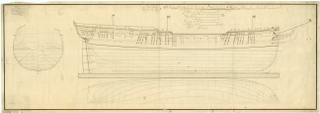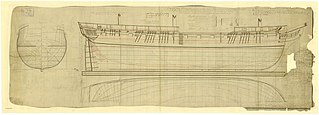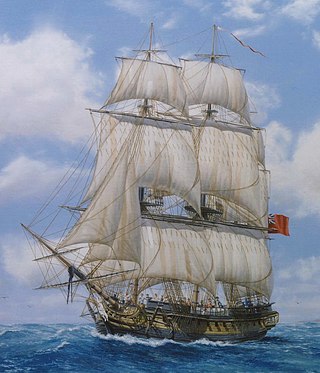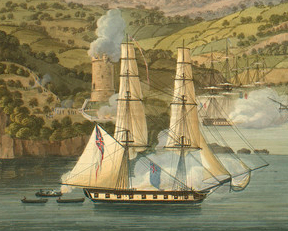
HMS Boadicea was a frigate of the Royal Navy. She served in the Channel and in the East Indies during which service she captured many prizes. She participated in one action for which the Admiralty awarded the Naval General Service Medal. She was broken up in 1858.

HMS Active was a Royal Navy fifth-rate frigate launched on 14 December 1799 at Chatham Dockyard. Sir John Henslow designed her as an improvement on the Artois-class frigates. She served during the French Revolutionary Wars and the Napoleonic Wars, capturing numerous enemy vessels. Her crews participated in one campaign and three actions that would later qualify them for the Naval General Service Medal. She returned to service after the wars and finally was broken up in 1860.

HMS Cerberus was a 32-gun fifth-rate frigate of the Royal Navy. She served in the French Revolutionary and the Napoleonic Wars in the Channel, the Mediterranean, the Adriatic, and even briefly in the Baltic against the Russians. She participated in one boat action that won for her crew a clasp to the Naval General Service Medal (NGSM). She also captured many privateers and merchant vessels. Her biggest battle was the Battle of Lissa, which won for her crew another clasp to the NGSM. She was sold in 1814.

HMS Havannah was a Royal Navy 36-gun fifth-rate frigate. She was launched in 1811 and was one of twenty-seven Apollo-class frigates. She was cut down to a 24-gun sixth rate in 1845, converted to a training ship in 1860, and sold for breaking up in 1905.

HMS Melampus was a Royal Navy fifth-rate frigate that served during the French Revolutionary and Napoleonic Wars. She captured numerous prizes before the British sold her to the Royal Netherlands Navy in 1815. With the Dutch, she participated in a major action at Algiers and, then, in a number of colonial punitive expeditions in the Dutch East Indies.
HMS Atalante was a 16-gun brig-sloop of the Royal Navy. She was formerly the French Atalante, captured in 1797. She served with the British during the French Revolutionary and Napoleonic Wars, and was wrecked in 1807.
Admiral Sir Lawrence William Halsted GCB was an officer of the Royal Navy who served during the American War of Independence and the French Revolutionary and Napoleonic Wars.

HMS Scout was a Cruizer-class brig-sloop built by Peter Atkinson & Co. at Hull and launched in 1804. She participated in a number of actions and captured several privateers in the Mediterranean during the Napoleonic Wars. The Navy sold her in 1827. In 1829 she reappeared as the British Southern Whale Fisheries whaler Diana. Diana made three voyages for Daniel Bennett & Son until condemned after an on-board explosion in April 1843 towards the end of her fourth voyage.

His Majesty's hired armed cutter Telemachus served the Royal Navy from 17 June 1795 until 15 January 1801. She was of 1285⁄95 tons (bm), and carried fourteen 4-pounder guns. During her five and a half years of service to the Royal Navy she captured eight French privateers as well as many merchant vessels.

HMS Success was a 32-gun Amazon-class fifth-rate frigate of the British Royal Navy launched in 1781, which served during the American Revolutionary, French Revolutionary and Napoleonic Wars. The French captured her in the Mediterranean on 13 February 1801, but she was recaptured by the British on 2 September. She continued to serve in the Mediterranean until 1811, and in North America until hulked in 1814, then serving as a prison ship and powder hulk, before being broken up in 1820.
Two vessels have borne the designation, His Majesty's hired armed cutter Lion. The first served during the French Revolutionary Wars, capturing five privateers and several merchant vessels. The second served briefly at the start of the Napoleonic Wars. Both vessels operated in the Channel. The two cutters may have been the same vessel; at this juncture it is impossible to know. French records report that the French captured the second Lion in 1808 and that she served in the French Navy until 1809.

HMS Procris was a Cruizer-class brig-sloop launched in 1807. She served at the second battle of Copenhagen. She then went out to the East Indies where she spent the rest of her active service, including participating in the 1811 invasion of Java. She returned to Britain in 1814 and was sold the next year. She then became a merchantman, while retaining her name. She traded primarily with North America but on a voyage in the Mediterranean an armed Greek brig captured her. However, her master was able to regain control. She was wrecked on 25 August 1839.

HMS Harpy was a Royal Navy Diligence-class brig-sloop, launched in 1796 and sold in 1817. She was the longest lived vessel of her class, and the most widely travelled. She served in both the battle of Copenhagen and the British invasion of Java, took part in several actions, one of which won for her crew a clasp to the Naval General Service Medal, and captured numerous privateers. The Navy sold her in 1817.
Éole was an 18-gun corvette of the French Navy, launched, captured, and later commissioned in the Royal Navy in 1799 as HMS Nimrod after her capture by HMS Solebay. She was then "the finest and most handsome ship-sloop in the British navy". She was sold in 1811. Nimrod made three whaling voyages between 1811 and 1819. On her first she captured several American whalers. Nimrod was last listed in 1820.

HMS Echo, launched in 1797 at Dover, was a sloop-of-war in the Royal Navy. She served on the Jamaica station between 1799 and 1806, and there captured a small number of privateers. The Navy sold her in 1809 and she became a whaler. She made four complete whale-hunting voyages but was wrecked in the Coral Sea in April 1820 during her fifth whaling voyage.
HMS Nimrod was a brig-sloop of the British Royal Navy, launched in 1812. She spent her war years in North American waters, where she captured one small privateer, assisted in the capture of another, and captured or destroyed some 50 American vessels. After the war she captured smugglers and assisted the civil authorities in maintaining order in Tyne. She was wrecked in 1827 and so damaged that the Navy decided she was not worth repairing. A private ship-owner purchased Nimrod and repaired her. She then went on to spend some 20 years trading between Britain and Charleston, the Mediterranean, Australia, and India. She was last listed in 1851.
Royal George was launched in 1803 as a brig for the Revenue Service. The Royal Navy purchased her in 1806 and renamed her HMS Bustard. She served on active duty between 1808 and 1815, distinguishing herself in operations in the Mediterranean. She then sailed to the West Indies. The Royal Navy sold her in 1815 and she became the whaler Royal George. She made three whaling voyages and was lost in 1825 on her fourth.
HMS Requin was the French Navy cutter Requin, launched at Boulogne in 1794. HMS Thalia captured Requin in 1795. Requin captured one small French privateer and participated in the capture of Suriname before wrecking in 1801.

HMS Dover was a 38-gun troopship, previously the French corvette Bellona, launched at Venice in 1808. She was captured at Lissa in 1811. She served as a troopship and transport until circa 1819. She then became the flagship for the Admiral commanding the Leith station. She was used for harbour service from 1825, and was sold in 1836.
HMS Richmond was a Confounder-class gunbrig, launched at Itchenor in February 1806. She captured several small privateers and merchantmen off the Iberian peninsula before the Royal Navy sold her in 1814. After the Navy sold her, she became the mercantile Ben Jonson.












